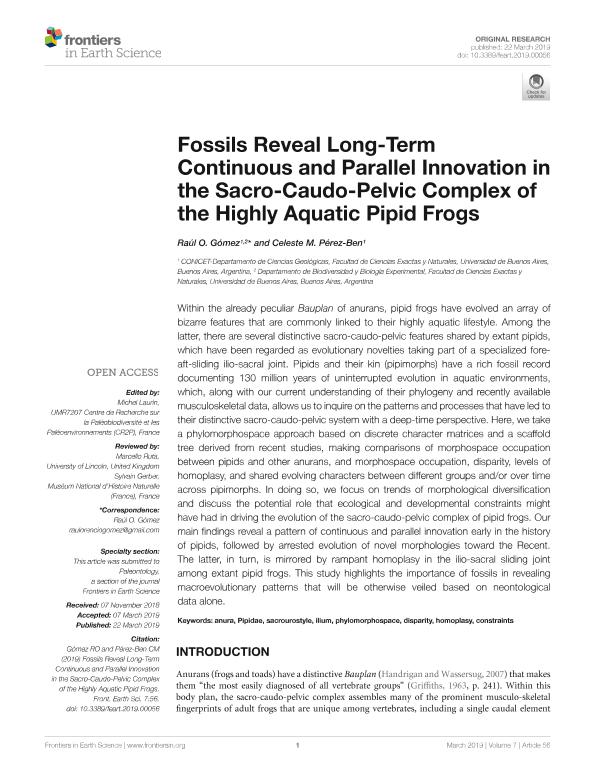Mostrar el registro sencillo del ítem
dc.contributor.author
Gomez, Raul Orencio

dc.contributor.author
Pérez Ben, Celeste Marina

dc.date.available
2020-09-04T20:58:36Z
dc.date.issued
2019-02
dc.identifier.citation
Gomez, Raul Orencio; Pérez Ben, Celeste Marina; Fossils reveal long-term continuous and parallel innovation in the sacro-caudo-pelvic complex of the highly aquatic pipid frogs; Frontiers Media S.A.; Frontiers in Earth Science; 7; 56; 2-2019; 1-15
dc.identifier.uri
http://hdl.handle.net/11336/113308
dc.description.abstract
Within the already peculiar Bauplan of anurans, pipid frogs have evolved an array of bizarre features that are commonly linked to their highly aquatic lifestyle. Among the latter, there are several distinctive sacro-caudo-pelvic features shared by extant pipids, which have been regarded as evolutionary novelties taking part of a specialized fore-aft-sliding ilio-sacral joint. Pipids and their kin (pipimorphs) have a rich fossil record documenting 130 million years of uninterrupted evolution in aquatic environments, which, along with our current understanding of their phylogeny and recently available musculoskeletal data, allows us to inquire on the patterns and processes that have led to their distinctive sacro-caudo-pelvic system with a deep-time perspective. Here, we take a phylomorphospace approach based on discrete character matrices and a scaffold tree derived from recent studies, making comparisons of morphospace occupation between pipids and other anurans, and morphospace occupation, disparity, levels of homoplasy, and shared evolving characters between different groups and/or over time across pipimorphs. In doing so, we focus on trends of morphological diversification and discuss the potential role that ecological and developmental constraints might have had in driving the evolution of the sacro-caudo-pelvic complex of pipid frogs. Our main findings reveal a pattern of continuous and parallel innovation early in the history of pipids, followed by arrested evolution of novel morphologies toward the Recent. The latter, in turn, is mirrored by rampant homoplasy in the ilio-sacral sliding joint among extant pipid frogs. This study highlights the importance of fossils in revealing macroevolutionary patterns that will be otherwise veiled based on neontological data alone.
dc.format
application/pdf
dc.language.iso
eng
dc.publisher
Frontiers Media S.A.

dc.rights
info:eu-repo/semantics/openAccess
dc.rights.uri
https://creativecommons.org/licenses/by-nc-sa/2.5/ar/
dc.subject
ANURA
dc.subject
CONSTRAINTS
dc.subject
DISPARITY
dc.subject
HOMOPLASY
dc.subject
ILIUM
dc.subject
PHYLOMORPHOSPACE
dc.subject
PIPIDAE
dc.subject
SACROUROSTYLE
dc.subject.classification
Paleontología

dc.subject.classification
Ciencias de la Tierra y relacionadas con el Medio Ambiente

dc.subject.classification
CIENCIAS NATURALES Y EXACTAS

dc.title
Fossils reveal long-term continuous and parallel innovation in the sacro-caudo-pelvic complex of the highly aquatic pipid frogs
dc.type
info:eu-repo/semantics/article
dc.type
info:ar-repo/semantics/artículo
dc.type
info:eu-repo/semantics/publishedVersion
dc.date.updated
2020-07-08T18:55:26Z
dc.identifier.eissn
2296-6463
dc.journal.volume
7
dc.journal.number
56
dc.journal.pagination
1-15
dc.journal.pais
Suiza

dc.journal.ciudad
Lausana
dc.description.fil
Fil: Gomez, Raul Orencio. Universidad de Buenos Aires. Facultad de Ciencias Exactas y Naturales. Departamento de Ciencias Geológicas; Argentina. Universidad de Buenos Aires. Facultad de Ciencias Exactas y Naturales. Departamento de Biodiversidad y Biología Experimental; Argentina. Consejo Nacional de Investigaciones Científicas y Técnicas. Oficina de Coordinación Administrativa Ciudad Universitaria; Argentina
dc.description.fil
Fil: Pérez Ben, Celeste Marina. Universidad de Buenos Aires. Facultad de Ciencias Exactas y Naturales. Departamento de Ciencias Geológicas; Argentina. Consejo Nacional de Investigaciones Científicas y Técnicas. Oficina de Coordinación Administrativa Ciudad Universitaria; Argentina
dc.journal.title
Frontiers in Earth Science
dc.relation.alternativeid
info:eu-repo/semantics/altIdentifier/url/https://www.frontiersin.org/articles/10.3389/feart.2019.00056/full
dc.relation.alternativeid
info:eu-repo/semantics/altIdentifier/doi/http://dx.doi.org/10.3389/feart.2019.00056
Archivos asociados
